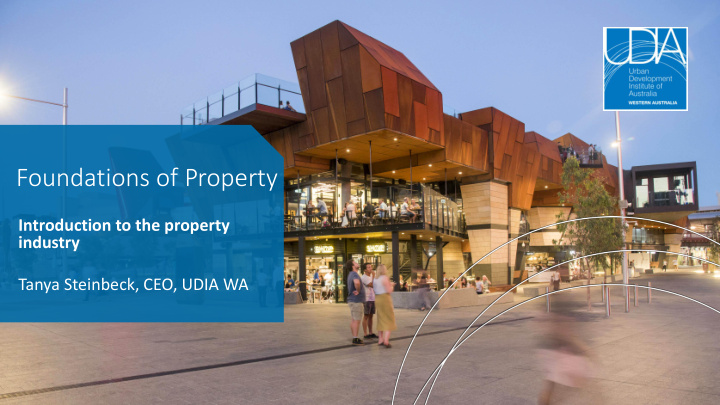



Foundations of Property Introduction to the property industry Tanya Steinbeck, CEO, UDIA WA
What is an asset class? • A category of investments that exhibit similar characteristics in the marketplace. • The investments within a single asset class are expected to: • have similar risks and returns • be subject to the same laws and regulations • perform in a similar manner in particular market conditions. • Each different asset class is expected to: • reflect different risk and return characteristics • perform differently in different market conditions. • There are four main types of asset classes, each categorised into either defensive or growth.
Potential Asset class Characteristics Risk return Suitable for investors who have a short term outlook, a low tolerance to Low Low Cash risk, or if market volatility is high. includes bank deposits, term deposits, savings Provides a stable and low risk income, usually equally in the form of regular interest payments. and cheque accounts and cash management Defensive assets No recommended minimum timeframe. trusts Can be more volatile than cash, but are still relatively stable. Low/ Moderate Fixed Interest (generating income) Generally operate in the same way as a loan. Moderate includes government bonds, corporate bonds, Income return is usually in the form of regular interest payments for an agreed period of time. mortgages and hybrid securities Minimum suggested time frame: 1 – 3 years Has a higher risk than fixed interest but less risk than equities. Moderate/ Moderate/ Property Less liquid than other asset classes resulting in a higher recommended High High includes direct investments in residential, minimum timeframe. Entry and exit costs significantly higher. industrial and commercial property and can also Minimum suggested timeframe: include indirect investment in listed property 7+ years Growth assets vehicles such as REITS Returns usually include capital growth or loss and income through High High dividends which may be franked (ie the company has already paid tax on (capital growth and Equities the earnings). The most volatile asset class but over long periods of time, on average, income) includes Australian equities and International has achieved higher investment returns. equities Involves part ownership of a company, enabling investor to share in the profits and future growth. Currency valuations can affect performance of International equities. Minimum suggested timeframe: 5 – 7 years Source: Australian Investors Association
Property as a wealth creation in investment • Real estate investment trusts (REITs) • Residential • Commercial office • Retail • Industrial
Source: Property Council of Australia
Real Estate In Investment Trusts (A (A-REITs) • A unitised portfolio of property assets, listed on the Australian Stock Exchange (ASX). They are an alternative to direct property investment and can be used to provide portfolio diversification. • A REIT is a diversified and professionally managed portfolio of real estate assets that enables investors to access a property portfolio which may include commercial, industrial, retail or a mix of these real estate assets which would not otherwise be available to the individual investor. • REITs may either invest in property locally in Australia or internationally. Investors can gain the benefit of any increase in value in the underlying asset and from regular rental income generated from the properties owned. Source: Australian Investors Association
Real Estate In Investment Trusts (A (A-REITs) • A-REITs are designed to generate wealth in two ways: exposure to the value of the real estate assets that the trust owns and the accompanying capital growth, and rental income. • The fund manager selects the investment properties and is responsible for all administration, improvements, maintenance and rental. • While each A-REIT will have its own of characteristics, the properties selected are usually diversified across regions, lease lengths and tenant types. Some A-REITs specialise in particular sectors, and usually fall into one of the following categories: • Industrial trusts invest in warehouses, factories, and industrial parks • Office trusts include medium- to large- scale office buildings in and around major cities • Hotel and leisure trusts invest in hotels, cinemas and theme parks • Retail trusts invest in shopping centres and similar assets • Diversified trusts invest in a mixture of industrial, offices, hotels and retail property. Source: ASX
Residential property
In Investing in in tr traditional residential (apartments, la land and house and la land) Pros Cons Low volatility Valuation Taxation High capital costs Capital growth Liquidity Long term Costs Demand Locality risk Mining Interest rates Rent increases Negative gearing
Source: UDIA WA
Commercial property
Retail property
In Industrial property
Source: Savills
Foundations of Property Introduction to the property industry Tanya Steinbeck, CEO, UDIA WA
Recommend
More recommend